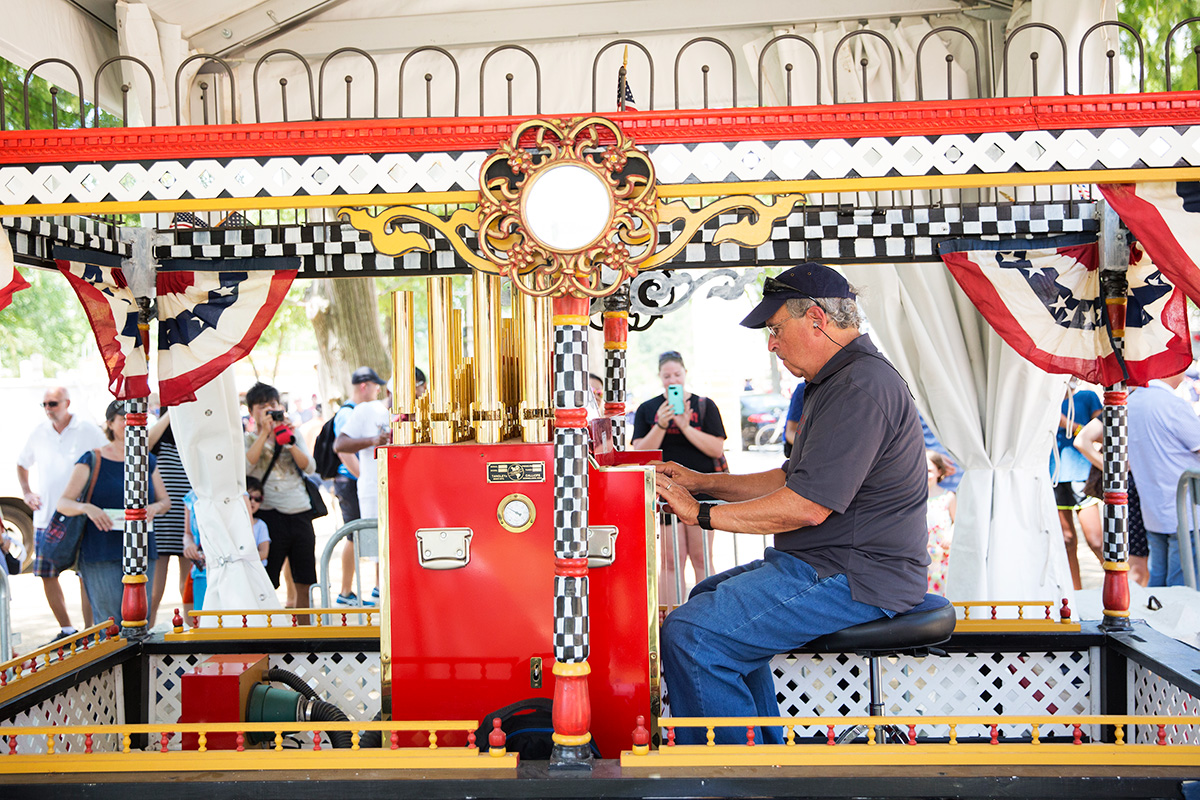The Calliope and the Clergy

For the last few days, a nostalgic sound has been wafting through the Folklife Festival. It’s a familiar sound but from a likely unfamiliar musical instrument.
This is the calliope (pronounced kuh-LIE-o-pee or KALLY-ope), once commonly associated with circuses. The original version drew steam—either from carousels or steamships—through the windchest and out a series of brass whistles, controlled by a piano keyboard. Since 1910, calliopes have run on electricity, pushing compressed air through instead of steam.
This particular calliope belongs to David Tetrault, who drove it up from Williamsburg, Virginia, hitched to a pickup truck. For such an old-timey sound, it was actually built in 2005; he has an antique one at home that he figured too fragile for the journey to Washington, D.C. He’s been parked across from the entrance to the National Museum of Natural History, filling in the time between Cookhouse demonstrations with lively tunes from the turn of the nineteenth century—or as he calls, “music that’s way behind the times.”
“Somebody’s got to play this music,” he jokes. “It might as well be me.”
Around that period, he says, American popular music was shifting from the steady marches of John Philip Sousa to more unexpected, syncopated rhythms. Tetrault’s musical inspiration came from his mother, who played these offbeat styles as a silent film pianist.
He plays the same songs on the calliope at festivals, harkening back to the “golden age” of circus in the early 1900s, when touring circuses paraded through towns to attract audiences—the calliope usually at the end. Sometimes he plays them on piano in the memory care ward of retirement homes, sparking memories in patients with Alzheimer’s or dementia.
“I’ve seen people who can’t remember their own names sing along to every song I’m playing,” he says.

It’s not the only way Tetrault has offered emotional support. He is also an Episcopal priest, and for twelve years he traveled alongside the Ringling Bros. and Barnum & Bailey Circus as the organization’s chaplain. He played a unique role, understanding both the spiritual needs of people and the challenges that circus folk face.
“The culture needs ritual,” he assures. “It’s a ritual culture. They have to deal with fear all the time. When a show goes out for a year, babies are born, people get married, there are deaths, there are illnesses. There’s all kinds of stuff. They need someone who can come in and understand the life, and then address the issues.”
Many performers have their own preshow customs in the face of risking broken bones, burns, and worse. Tetrault and the clergy were in charge of another ritual: blessing the tents.
“This is sacred for those people,” he says. “The circus ring is a sacred place.”
It’s sacred, but it’s not exclusive. Tetrault says they welcomed all people, all denominations. The goal was grounding and counseling, not convincing anyone of anything. The same philosophy extends outside of the spiritual—all the circus troupes at the Folklife Festival have stressed their messages of inclusivity, regardless of ethnicity, socioeconomic status, education, age, or physical or cognitive ability.
“The circus is always about opening to more,” he concluded. “They’re always pushing the edges of gravity. No boundaries! Take the boundaries away!”
With this collective welcoming attitude, Tetrault felt immediately comfortable and familiar with longtime circus stars at the Festival, even those who he had never met before. Here, those in the background are brought to the forefront, whether giving guidance backstage or bringing up the rear of a parade.
Elisa Hough is the editor for the Center for Folklife and Cultural Heritage.

